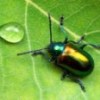
Nicrophorus orbicollis, Sexton Beetle, Illinois
The intrepid students of IB 468 caught this beautiful black burying beetle during a field trip to Dixon Springs, Illinois. They were kind enough to let me photograph it before it went to the collection.
Rather than me blathering on about this insect's biology, I'll direct you instead to the N. orbicollis wikipedia page. Wikipedia is normally hit-or-miss with regard to insects, but the page for N. orbicollis is an example of the medium at its best.
One thing about carrion beetles, though. Pretty, yes. But they smell terrible, and I spent 5 minutes washing my hands after handling it for this shot.
photo details: Canon 100mm f2.8 macro lens on a Canon EOS 50D
ISO 200, f/11, 1/200 sec, indirect strobe bounced off white tray

There's an article in the latest "Natural History" about a species in this beetle genus that has shifted from small corpses to snake egg clutches as its preferred food. It still has the ability to process dead mice, etc. for its young, but apparently is rather clumsy at it. With snake eggs, much less processing is required, just breach the leathery shell and move in.
The wikipedia entry you point to say (2nd sentence under "Behavior") that "If another male enters the area, the two males will fight to the death and the winner will claim the carcass."
Is that true? I knew there was often a struggle over small carrion, but I always assumed that they tussled a la stag beetles and the loser(s) flew off to try again.
Carol-
Good catch. That part of the article seems to have been added later, by a different contributor than the one who added the bulk of the original article. Since that bit of information about the male fights doesn't have a reference, I'd treat it with a grain of salt.
Hmm, another great coleopterous mite habitat - although the Wikipedia entry gives the mites short shrift and is hardly informative for such a famous set of symbiotes. Still, Alex, great choice of mite habitats the last few Fridays.
I remember visiting David Sloan Wilson's lab when he was at the Kellogg Biological Station and he had mountains of shoe boxes full of small dead animals, beetles, and, of course, mites. Can't remember any particularly bad smells, but perhaps the happy memories of mites have buried them.
Very nice shot! Those beetles tend to dislike light and are very active making them a pain to photograph.
Dave- although you can't see them so well in this photo, there were a couple of mites hanging on to the underside of the prothorax in this beetle.
Derek- that's so true! My technique with this beetle was to gently palm it to the rock until it stopped walking, wait a bit, then remove my hand. This gave me 2-3 seconds in the clear before it started off running again, enough to snap a couple of photos. After 15 minutes I got maybe 3 useable images. And a really stinky hand.